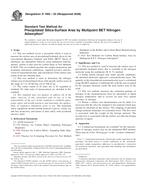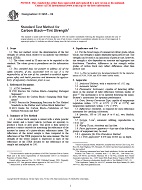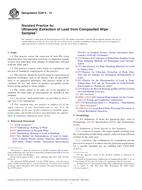1.1 This test method covers the estimation of the net heat of combustion at constant pressure in SI units (megajoules per kilogram) or inch-pound units [Btu per pound].
1.2 This test method is purely empirical and is applicable only to liquid hydrocarbon fuels derived by normal refining processes from conventional crude oil, which conform to the requirements of specifications for aviation gasolines, or aircraft turbine and jet engine fuels of limited boiling ranges and compositions as described in Note 1.
Note 1 – The estimation of the net heat of combustion of a hydrocarbon fuel from aniline-gravity product is justifiable only when the fuel belongs to a well-defined class for which a relation between heat of combustion and aniline-gravity product has been derived from accurate experimental measurements on representative samples of that class. Even in this case, the possibility that the estimates may be in error by large amounts for individual fuels should be recognized. The classes of fuels used to establish the correlation presented in this test method are represented by the following specifications:
| Fuel | Specification |
| Aviation gasoline fuels: | Specification D 910 |
| Grades 80, 82, 100/130, and 115/145 | Specification D 6227 |
| DEF STAN 91–90 | |
| NATO Code F-18 | |
| Aviation turbine fuels: | MIL-DTL-5624 |
| JP-4,Avtag/FSII | DEF STAN 91–88 |
| NATO Code F-40 | |
| JP-5,Avcat/FSII | MIL-DTL-5624 |
| DEF STAN 91–86 | |
| NATO Code F-44 | |
| Jet A, Jet A-1, Avtur | Specification D 1655 |
| DEF STAN 91–91 | |
| NATO Code F-35 |
1.3 This test method is not applicable to pure hydrocarbons. It is not intended as a substitute for experimental measurements of heat of combustion.
1.4 The heat of combustion may also be determined in SI units by Test Method D 4529. Test Method D 4529 requires calculation of a single equation for all aviation fuels with a precision equivalent to that of this test method.
1.5 The values stated in either SI units or inch-pound units are to be regarded separately as standard. The values stated in each system may not be exact equivalents; therefore, each system shall be used independently of the other. Combining values from the two systems may result in non-conformance with the standard.
1.6 This standard does not purport to address all of the safety concerns, if any, associated with its use. It is the responsibility of the user of this standard to establish appropriate safety and health practices and determine the applicability of regulatory limitations prior to use.
Product Details
- Published:
- 12/01/2008
- Number of Pages:
- 8
- File Size:
- 1 file , 110 KB
- Redline File Size:
- 2 files , 200 KB


